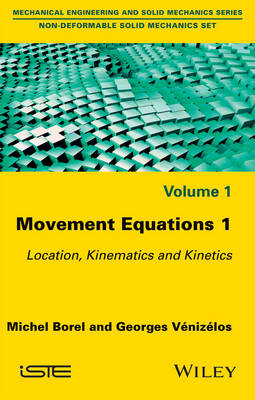
Movement Equations 1
ISTE Ltd and John Wiley & Sons Inc (Verlag)
978-1-78630-032-4 (ISBN)
This volume deals with the elements required for establishing the equations of motion when dealing with solid bodies. Chapter 1 focuses on the systems of reference used to locate solid bodies relative to the observer, and demonstrates how to describe their position, orientation, and evolution during their motion. Chapter 2 introduces descriptors of motion such as velocity and acceleration, and develops the concept of torsor notation in relation to these descriptors. Finally, Chapter 3 concerns the notions of mass and inertia, as well as the kinetic torsor and dynamic torsor which consolidate the kinematic and kinetic aspects in a single concept.
Michel Borel was previously a lecturer in mechanics at the CNAM Center in Versailles, Associate Professor at École nationale supérieure du pétrole et des moteurs (ENSPM), and an engineer for the company Bertin and at the General Armament Direction (DGA). Georges Vénizélos is Professor and Chair of mechanical systems design at Conservatoire National des Arts et Métiers (CNAM) in France. His research field concerns vibration control. mament Direction (DGA).
Introduction ix
Table of Notations xv
Chapter 1. Location of Solid Bodies 1
1.1. The notion of system of reference 1
1.2. Frame of reference 2
1.2.1. Setting up a frame of reference 2
1.2.2. Various types of frames of reference 9
1.3. Location of a solid body 14
1.3.1. The principle of locating a solid 15
1.3.2. Location parameters of a solid 15
1.3.3. Coordinates of the position vector 16
1.3.4. Exercises 20
1.4. Positioning of a system of reference connected to a solid 22
1.4.1. Several examples of location systems of reference 22
1.4.2. General location parameters 26
1.4.3. Euler angles 28
1.4.4. Changes of basis in the Euler representation 29
1.4.5. Exercises 36
1.5. Vector rotation R u ,α 44
1.5.1. Exercises 47
1.6. Other exercises 51
1.6.1. Exercise 7 – Location of an airplane – Euler angles 51
1.6.2. Exercise 8 – Vector rotation 55
1.6.3. Exercise 9 – Vector rotation 57
1.6.4. Exercise 10 –Vector rotation 59
Chapter 2. Solid Kinematics 63
2.1. Generalities on moving solids 63
2.1.1. Concept of a rigid material system 63
2.1.2. Notion of time 64
2.1.3. Kinematic components of a solid 65
2.2. Kinematics of a material point 66
2.2.1. Position vector 66
2.2.2. Trajectory of a material point in a reference frame 66
2.2.3. Velocity of a material point in a reference frame 67
2.2.4. Components of the velocity vector or velocity 68
2.2.5. Derivative of a vector in a basis 71
2.2.6. Acceleration vector of a material point in a reference frame 74
2.2.7. Exercises 79
2.3. Velocity field associated with the motion of the rigid solid 85
2.3.1. Fundamental formula for the velocity 85
2.3.2. Use of matrix notation 87
2.3.3. Velocity-distributing torsor 89
2.3.4. Partial distributing 89
2.4. Acceleration field of the rigid solid 91
2.4.1. Derivative in relation to the time of the rate of rotation 91
2.4.2. Derivation of a vector of the solid 92
2.4.3. Fundamental formula of acceleration 92
2.4.4. Matrix notation of the vectorial product 92
2.4.5. Exercises 93
2.5. Motion with fixed plane 102
2.5.1. Position of the problem 102
2.5.2. Instantaneous rotation center 104
2.5.3. Fixed and mobile centroids of the motion 106
2.5.4. The instantaneous center of rotation on the fixed centroid and on the movable centroid 107
2.5.5. Physical interpretation of the notions of fixed centroid and mobile centroid 108
2.5.6. Exercises 109
2.6. Combining motions within a mobile frame of reference 117
2.6.1. Position of the problem 117
2.6.2. Trajectory of a material point in the different frames 118
2.6.3. Combination of velocities 118
2.6.4. Combination of accelerations 123
2.6.5. Application exercises 128
2.7. Relative motion of two rigid solids in contact 141
2.7.1. Position of the problem 141
2.7.2. Velocity-distributing torsors 141
2.7.3. Characterization of motions 142
2.7.4. Nature of the contact between (S1) and (S2) 143
2.7.5. Exercises 145
2.8. Other exercises 156
2.8.1. Exercise 21 – Motion with fixed plane 156
2.8.2. Exercise 22 – Combination of motions 160
2.8.3. Exercise 23 – Kinematics of contact in a system 169
Chapter 3. Kinetics of Solid Bodies 177
3.1. The mass of a continuous mechanical set (D ) 177
3.1.1. The notion of measure on a continuous mechanical set 178
3.1.2. The volume and the mass of a continuous mechanical set 178
3.2. Center of the measure of μ on (D ) 179
3.2.1. Definition 179
3.2.2. Uniqueness of the center of measure 179
3.2.3. Center of measure of two disjoint sets 180
3.2.4. Coordinates of the center of measure in a system of reference (λ) 181
3.3. Interpretation of the notion of center of measure 183
3.4. Kinetic torsor of a mechanical set (D ) 183
3.4.1. Definition – linear momentum 183
3.4.2. Kinetic torsor { } S pλ of a rigid solid body 185
3.4.3. Inertia operator OS ( | ) I S m 186
3.4.4. Kinetic torsor and change of basis 196
3.5. Dynamic torsor of a mechanical set (D ) 198
3.5.1. Definition 198
3.5.2. Dynamic torsor of the rigid solid body (S) 199
3.6. Kinetic energy of a mechanical set (D ) 206
3.6.1. Definition 207
3.6.2. Kinetic energy of the free rigid solid body (S) 207
3.6.3. Derivatives of the kinetic energy - Lagrangian 213
3.6.4. Exercises 223
3.6.5. Kinetic energy of a constrained solid 238
3.7. Partition of a continuous mechanical set (D ) 239
Bibliography 241
Index 243
| Erscheinungsdatum | 24.09.2016 |
|---|---|
| Verlagsort | London |
| Sprache | englisch |
| Maße | 165 x 241 mm |
| Gewicht | 558 g |
| Themenwelt | Naturwissenschaften ► Physik / Astronomie ► Mechanik |
| Technik ► Maschinenbau | |
| ISBN-10 | 1-78630-032-X / 178630032X |
| ISBN-13 | 978-1-78630-032-4 / 9781786300324 |
| Zustand | Neuware |
| Haben Sie eine Frage zum Produkt? |
aus dem Bereich


